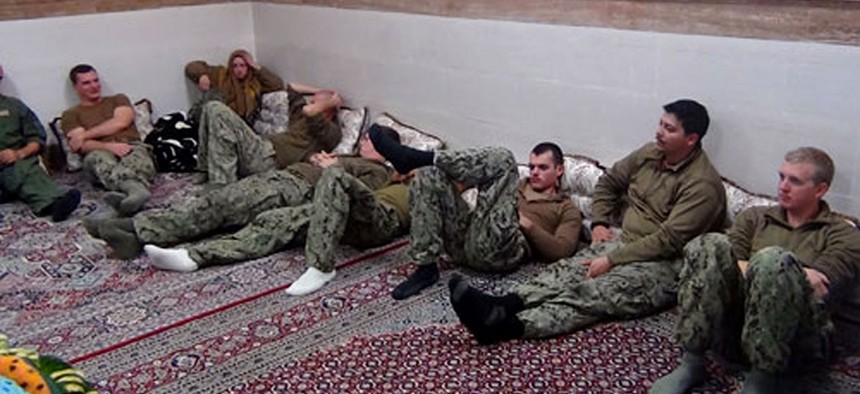
Iran released photos of the detained sailors Wednesday. AP
Iran Releases 10 American Sailors and Their Boats
Iran freed them a day after they inadvertently crossed into Iranian territorial waters.
Iran has freed the 10 U.S. sailors who strayed into its territorial waters Tuesday, Iranian and U.S. officials say.
The two U.S. vessels had been en route to Kuwait from Bahrain on a routine exercise, when, a senior defense official said, contact was lost with them Tuesday. Iran said they were detained and held at a base on Farsi Island.
A statement from Iran’s Islamic Revolution Guards Corps said “technical and operational examinations” of the vessels showed they had inadvertently entered Iranian waters and were released into international waters after an apology. Rear Admiral Ali Fadavi, the commander of the IRGC Navy, said earlier Wednesday the U.S. vessels had developed technical problems with their navigation systems. (You can watch them being released here, courtesy of the AP.)
The sailors left Farsi Island at 8:43 a.m. GMT aboard their two boats and were picked up by Navy aircraft. Their boats are being returned to Bahrain, home to the U.S. Fifth Fleet.
The U.S. Navy said the American sailors—nine men and a woman—had returned safely; there were no indications they had been harmed, the Navy said.
“The Navy will investigate the circumstances that led to the sailors’ presence in Iran,” the statement said.
Here’s more from the AP about the sailors and their vessels:
The sailors were part of Riverine Squadron 1 based in San Diego and were deployed to the U.S. Navy's 5th Fleet in Bahrain. When the U.S. lost contact with the boats, ships attached to the USS Harry S Truman aircraft carrier strike group began searching the area, along with aircraft flying off the Truman.
The Riverine boats were not part of the carrier strike group, and were on a training mission, the officials said. The craft are not considered high-tech and don't contain any sensitive equipment, so there were no concerns about the Iranians gaining access to them, they added. The officials spoke on condition of anonymity because they were not authorized to discuss the sensitive incident publicly.
The incident was seen as a test case for newly improved U.S.-Iranian relations. Ties, long frozen after the 1979 Islamic revolution and the subsequent hostage crisis at the U.S. Embassy in Tehran, have begun to slowly thaw. The U.S. and other world powers successfully negotiated with Iran on its nuclear program, and the Islamic Republic is just days away from implementing its end of the nuclear deal—for which it will get much-needed sanctions relief.
The detaining of the Americans could have derailed some of those efforts, but their relatively quick release points to the success of diplomacy. Indeed, the BBC notes the Iranian media had been uncharacteristically measured in its reporting of the American sailors.
Press TV, the Iranian state-run broadcaster, reported that Mohammad Javad Zarif, the Iranian foreign minister, had discussed the issue with John Kerry, the U.S. secretary of state, and “adopted a strong and firm stance.” A U.S. official, cited by the AP, said Kerry “personally engaged” with Zarif over the incident. The two men had negotiated closely over the nuclear deal, and reportedly developed a rapport during the often tense talks.






